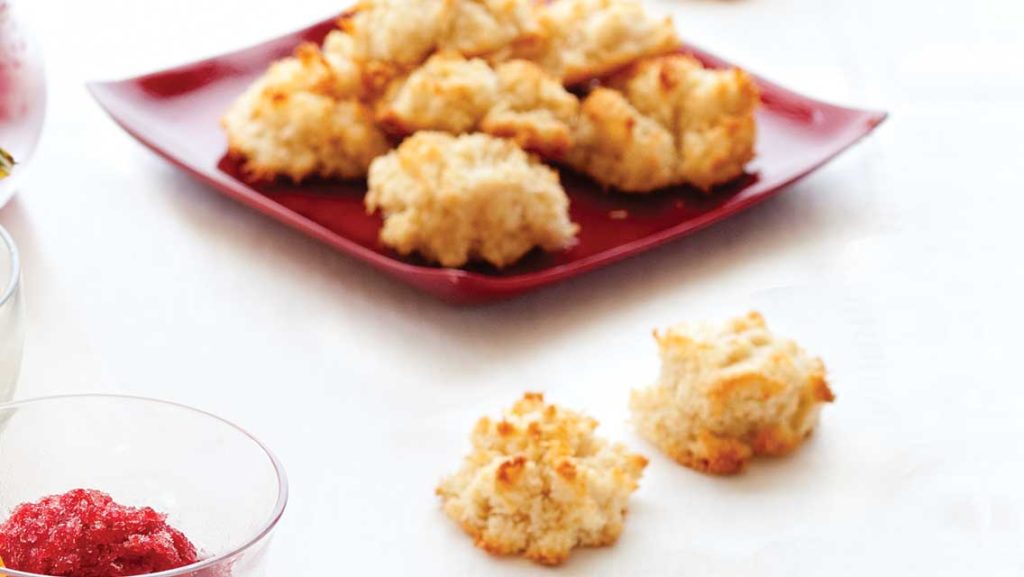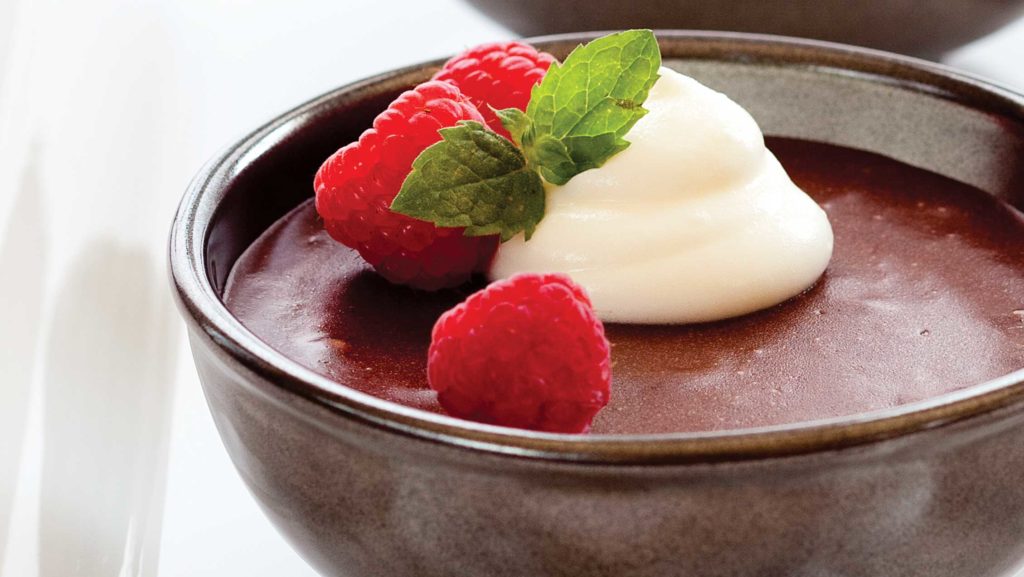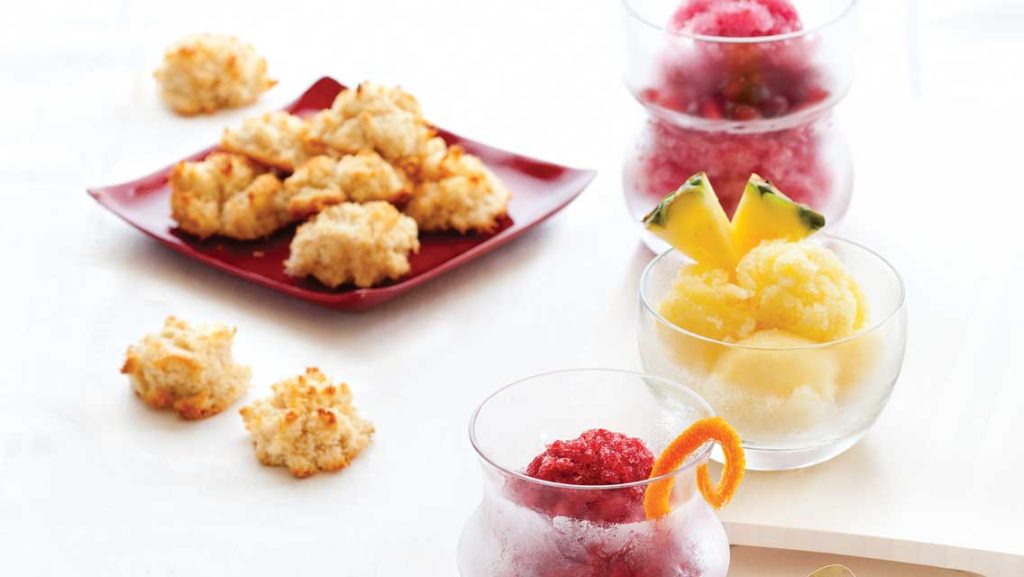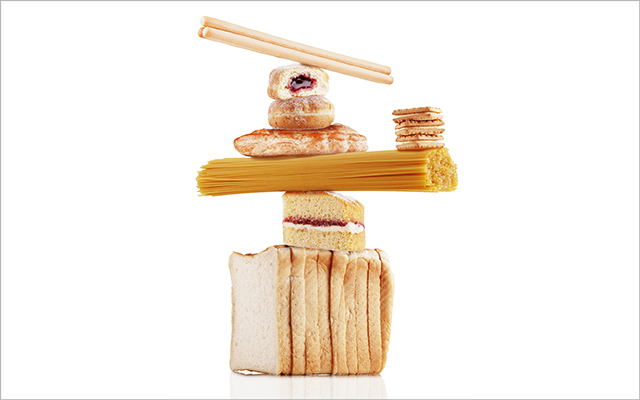Faced with the enviable task of making a tempting dessert, many of us envision moist cakes, crisp cookies and flaky pie crusts — and immediately reach for a bag of flour. For more and more people with gluten sensitivities, though, this main ingredient is off limits. Those who can’t tolerate wheat-based products often assume they must simply learn to deny themselves the sweet life.
But as many of the world’s best chefs will tell you, giving up on gluten is not only easier than ever, but it can also be preferable, since so many naturally flour-free treats are more complex, satisfying and, in many cases, healthier than the doughy after-dinner norm. (For more on the physical benefits of cutting down on wheat flour, visit “The Truth About Grains: Whole and Refined.”)
Recipe builders have also become much more adept at incorporating flour substitutes into their gluten-free baked goods (which in the past, let’s face it, bore a disturbing resemblance to cardboard). Try a few of the recipes, tips and tricks offered here, and you’ll discover that gluten-free desserts don’t have to be a compromise. On the contrary, they can easily delight everybody at the table.
The Truth About Gluten
- Gluten is found in several grains, such as wheat, barley and rye. The average American eats about 150 pounds of wheat, and processed food that includes wheat, each year.
- Experts estimate that 30 to 40 percent of Americans, while not suffering from celiac disease, are gluten intolerant. They can experience significant chronic health problems as a result, and may run a greater risk for cancer and heart disease than celiac patients.
- The “amber waves of grain” that fed our grandparents more than 50 years ago have, for the most part, been replaced with modern, high-yield dwarf strains of wheat that contain more gliadin, a protein that increases appetite. (For more on modern wheat, read Wheat Belly: Lose the Wheat, Lose the Weight and Find Your Path Back to Health by William Davis, MD.)
- According to research by the Mayo Clinic, both celiac disease and gluten intolerance are more common today than they were in the 1950s. The researchers tested 50-year-old blood samples from Air Force recruits for gluten antibodies and compared them with new samples of present-day airmen. They found today’s recruits were 4.5 times likelier to have celiac disease than their 1950s counterparts.
- Gluten can cause inflammation, a leading cause of chronic diseases such as cancer and heart disease. If you’re sensitive, it may also create tiny fissures in the small intestine so that nutrients are not absorbed well, which can lead to mental health and behavioral problems.
- A 2002 review in the New England Journal of Medicine linked 55 different disorders to eating gluten, including type 1 diabetes, anemia and epilepsy. (For more on the dangers of gluten, visit “Gluten: The Whole Story.”)
All-Purpose Gluten-Free Flour Mix
“You can use this for pretty much anything,” says chef and cooking instructor Myra Kornfeld.
- 2 cups brown rice flour
- 2/3 cup potato starch
- 1/3 cup tapioca flour
- 1 tsp. xantham gum
Myra’s Top Five Flours
- “Brown rice flour is a good all-purpose flour. It’s mild in flavor, very nutritious and has a little bit of a gritty texture. I like to combine rice flour with nut flours — you really taste the nuttiness. I make a banana muffin where I use half brown rice flour and half ground-up walnuts, and the banana holds it all together.”
- “Almond flour is a nice-tasting nut flour. I love putting it into crusts, toppings — all kinds of things. Sometimes I use it in combination with brown rice flour, but I’ve also had really good success with it by itself. I make muffins with almond flour and flax seed flour, and they have nothing else holding them up except for eggs, and they are really light and tasty and have fabulous texture. I love almond flour with a little sorghum flour for pastry crust.”
- “Chickpea-fava bean flour is a favorite. It has a lot of protein, and it adds moisture and structure in baking so I like to use it for cookies. Because it has a strong flavor, you have to use it with other strong-tasting flavors, like chocolate, spices and nut butters. I developed a peanut butter cookie that I’ve made about 500 times. It has chickpea-fava bean flour, peanut butter, and egg. It’s super-high protein, it doesn’t really give a big sugar rush, and it’s really good.”
- “Sorghum flour tastes rather like wheat flour. It’s neutral, high in protein, and it tends to work very well on its own. I make a gluten-free brownie with sorghum flour and eggs. I don’t use a gum, or any tapioca or potato starch. The chocolate holds it together, and the crumb is really delicious.”
- “Coconut flour is a newer flour on the market. It reacts completely differently from every other flour. It feels really, really light in the body, which I appreciate. The big thing about coconut flour is that it’s highly absorbent so you need quite a bit of liquid to process it. Besides lowering the amount of coconut flour in a recipe, you have to raise the amount of liquid.”
Quick & Easy Gluten-Free Desserts
- Ricotta cheese with berries and maple syrup is quick yet elegant. Top a small scoop of good-quality, whole-milk ricotta cheese with a sprinkle of fresh berries and a drizzle of maple syrup or honey.
- A simple square of dark chocolate can be a satisfying end to a meal. Look for artisanal dark chocolate with a high cocoa content and pair it with some nuts — perhaps almonds, walnuts or pistachios.
- For a sophisticated finish to a meal, serve a plate of dessert cheeses with nuts and fresh fruit, such as apples, figs and grapes. Try a soft, creamy cheese like chèvre; a hard cheese like aged Gouda; and a blue cheese such as Gorgonzola. Add another layer of flavor with a small bowl of fig jam, quince paste or truffle honey.
- Ice cream, gelato and sorbet are easy to find in a variety of flavors. Dress them up with a drizzle of honey or espresso, a sprinkle of toasted pine nuts or coconut, or a few fresh berries or nuts.
Recipes
Coconut-Almond Macaroons With Maple Sugar
Toasted, chewy and luscious, these coconut macaroons get a twist of flavor from almond flour. Feel free to drizzle cooled macaroons with melted dark chocolate.

Makes | 24 macaroons
Ingredients
- 4 egg whites
- Pinch of sea salt
- 1 tsp. vanilla extract and/or 1/2 tsp. almond extract
- 1/3 cup maple sugar
- 1 cup almond flour
- 1 1/2 cup unsweetened shredded coconut
Directions
- Beat egg whites with sea salt until they form stiff peaks.
- Fold in the vanilla and/or almond extract, maple sugar, almond flour, and shredded coconut.
- Spoon tablespoon-size mounds of batter onto a parchment-lined baking sheet.
- Bake at 350 degrees F for 10 to 12 minutes. Allow to cool for five minutes on the baking sheet, then transfer to a cooling rack. Store in an airtight container.
A Trio of Granitas
Refreshingly frosty, these fruit-based, slightly sweetened palate cleansers are very easy to make. All three recipes make about 1 quart each.
Pink Grapefruit and Honey Granita
Ingredients
- 1/2 cup honey
- 1 cup warm water
- 3 pink grapefruits, juiced, pulp included but seeds removed (about 2 to 21/2 cups)
Directions
- Dissolve the honey in warm water and add the grapefruit juice and pulp. Then follow directions for freezing below.
Pineapple Ginger Granita
Ingredients
- 1/2 cup honey
- 1 cup warm water
- 1 ripe pineapple, peeled, cored and cut into small pieces
- 2 tbs. minced fresh gingerroot
Directions
- Dissolve the honey in warm water and blend with pineapple in a blender until smooth.
- Add the minced ginger and blend about 30 seconds more. Then follow directions for freezing below.
Cranberry Orange Granita
Ingredients
- 2 cups freshly squeezed orange juice, divided
- 1/2 cup turbinado sugar (other sweeteners, such as honey, can also be used)
- Zest of one orange
- 8 ounces frozen cranberries
Directions
- Warm 1 cup of the orange juice and dissolve the sugar in it.
- Blend the reserved orange juice, zest and cranberries in a blender until smooth. Mix with the sweetened orange juice. Then follow directions for freezing below.
Freezing directions
- Pour the mixture into a 2-quart casserole or 9-by-13-inch pan and place in the freezer. Stir every hour or so until mixture is uniformly frozen, about five hours. Transfer the slushy granita to an airtight storage container and keep in the freezer until ready to serve.
Poached Pears
A classic dessert whose beauty and elegance belie its simplicity.

Serves | four
Ingredients
- 4 Bosc pears, peeled
- 3 cups tart cherry juice, unsweetened apple juice or pomegranate juice
- 1/4 cup honey
- 1/2 fresh vanilla bean, split
- 1/4 cup crème fraîche or mascarpone cheese
- 1/4 cup toasted hazelnuts
Directions
- Scoop out the core from the bottom of each pear using a melon baller. Make sure you have removed all the seeds, but keep the bottom of the pear intact.
- Add the fruit juice, honey and vanilla bean to a medium saucepan and bring to a simmer. Add the pears; if the pears are not covered with the poaching liquid, add water to cover them.
- Cover the pears with a circle of parchment paper that has a 1-inch diameter vent hole in the center of it. Cover with a lid and simmer gently for about 20 to 25 minutes. If a paring knife goes in easily, the pears are done.
- Remove the pears from the simmering liquid and place on a tray to cool.
- Continue to simmer the poaching liquid until it is reduced by half.
- Serve the pears drizzled with the cooled poaching liquid, a dollop of crème fraîche and a sprinkling of hazelnuts.
Chocolate Mousse
A small portion of this rich indulgence is just right. The traditional French method calls for raw eggs, so make sure you use fresh, organic, pastured eggs.

Serves | four
Ingredients
- 5 ounces bittersweet baking chocolate, broken into small pieces
- 4 ounces heavy cream
- 2 eggs, separated
- Pinch of sea salt
- Zest of one orange, or dash of Grand Marnier
Directios
- Place chocolate in a bowl. Gently heat the heavy cream until just about to simmer, and pour over the chocolate. Stir until the chocolate melts and the mixture is smooth.
- Stir in the egg yolks, one at a time, until smooth. Beat the egg whites separately with salt until stiff peaks form.
- Fold half of the egg whites into the chocolate mixture to lighten it, and then add the remaining egg whites, folding gently so the eggs do not deflate.
- Flavor with the orange zest or Grand Marnier.
- Pour into individual serving dishes. Chill for four to six hours or overnight.
- Garnish with a dollop of whipped cream before serving if desired.
Gluten-Free Goodness
Chef, cookbook author and cooking teacher Myra Kornfeld isn’t gluten intolerant. A growing number of people are, though, which is why she’s been teaching classes on gluten-free (as well as dairy-free) cooking for years. While choosing naturally flour-free desserts is a great way to go (you’ll find several recipes on these pages), there are times, she says, when you still crave traditional baked goods. Kornfeld, for example, loves muffins and uses gluten-free replacement flours to satisfy her craving: “I make coconut-flour muffins because I don’t want to eat loads of wheat.” (For her favorite replacement flours, see below.)
“There are so many people around with allergies, so it’s really good to have lots of alternative ways of doing things. But you still want to make absolutely delicious food — with no sacrifices,” she says.
“When I’m making something that’s gluten free, I always ask myself: Is it going to be delicious, or is it just going to be a really freaky substitute?”
Here, Kornfeld, the lead chef at MyFoodMyHealth.com and the author of The Healthy Hedonist (Simon & Schuster, 2005), lets us in on some of her sweet secrets for working with gluten-free flours.
Experience Life | There are so many gluten-free flours out now. Where does one begin?
Myra Kornfeld | Start with a gluten-free flour mix and see what it does. (Most mixes have two parts flour to one part starch — like potato starch or tapioca starch — and maybe a little xanthan gum.) Then start trying the single flours. You’ll want to see how each one feels in your system. Sometimes bean flours, for example, are harder to digest. I never use soybean flour — ever — for gluten-free baking. I think it’s a terrible flour. It’s very, very hard to digest.
EL | What is the No. 1 thing to keep in mind with gluten-free baking?
MK | You have to be willing to experiment. You can’t necessarily take your favorite recipe and just substitute a gluten-free flour mix. You can try it, but if it doesn’t work out, next time you may want to try a single flour or a mix of two flours. You’ll need to see if you need extra starch like tapioca or potato, or a gum, or whether you can get away without them. If you are making something with an ingredient that’s already gooey and sticky — eggs, purées, bananas and chocolate act as binders — you might not need all of those extra things. (For Kornfeld’s recipe for an all-purpose gluten-free flour mix, see below.)
EL | Ugh, that sounds complicated!
MK | I actually come from a “less-is-more” perspective. I do flour blends when I have to, but I always think it’s a great success story if I can do a flour-based dessert that needs only one gluten-free flour. For instance, molten chocolate cake, or lava cake, is soft and gooey, so it requires little flour. That’s a case where I could just put in a single flour, like almond or sorghum, and it’s going to work great because flour isn’t a major part of the recipe.
EL | What are your top-three tips for baking with gluten-free flours?
MK | (1) Gluten-free flours are delicate, so they need to be refrigerated or they will go rancid quickly. (2) Using warm liquids rather than cold ones, and adding them slowly, helps give structure to baked goods. (3) Using bread-loaf pans or muffin tins helps encourage gluten-free goods to hold their shape.
All of these recipes were created by Betsy Nelson (a.k.a. “That Food Girl”), a Minneapolis-based food stylist and recipe developer.





This Post Has 0 Comments